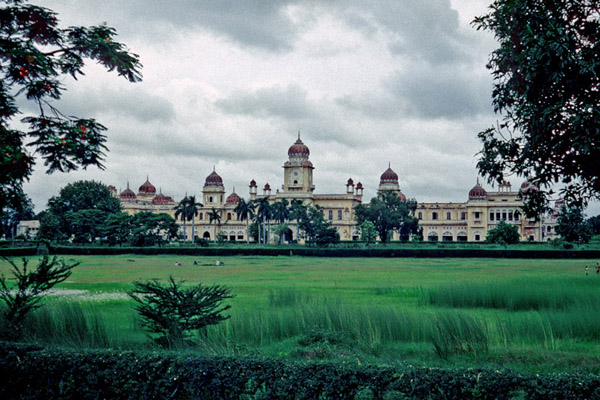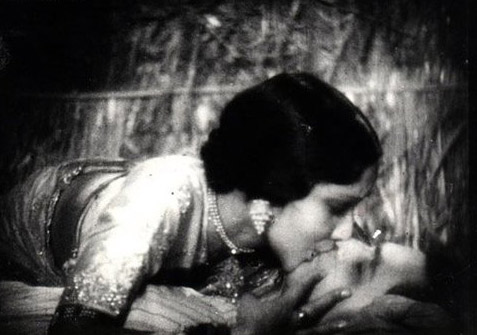|
Kavi Pradeep
Kavi Pradeep (born Ramchandra Narayanji Dwivedi; 6 February 1915 – 11 December 1998), was an Indian poet and songwriter who is best known for his patriotic song "''Aye Mere Watan Ke Logo"'' written as a tribute to the soldiers who had died defending the country during the Sino-Indian War. His first recognition came for his patriotic lyrics for the film '' Bandhan'' (1940). His status as a nationalistic writer got immortalised for writing a daringly patriotic song "Door Hato Ae Duniya Walo" (Move Away O Outsiders) in India's first golden jubilee hit '' Kismet'' (1943) because he was forced to go underground to avoid arrest immediately after the film's release that invited the ire of British government. In a career span of five decades, Kavi Pradeep wrote about 1,700 songs and nationalistic poems including the lyrics for some 72 films, including hits like "Chal Chal Re Naujawan" in film ''Bandhan'' (1940) and "Aao Bachcho Tumhein Dikhayen" and "De Dee Hame Azaadi" in the film ... [...More Info...] [...Related Items...] OR: [Wikipedia] [Google] [Baidu] |
Badnagar
Badnagar is a town, and a municipality in Ujjain district in the state of Madhya Pradesh, India. Badnagar Tehsil Headquarters is Badnagar town and it belongs to Ujjain Division. It is located 45 km towards west from District headquarters Ujjain. 244 km from the state capital, Bhopal, towards the east and 72 km from Indore. Badnagar is also famous for its fort, Amla Fort. Geography Badnagar is situated on the bank of river Chamla. Badnagar Tehsil is bounded by Badnawar Tehsil towards west, Depalpur Tehsil towards the south, Khachrod Tehsil towards north, Ujjain district towards the east. Indore City, Ujjain City, Ratlam City, Dhar City nearby cities to Badnagar. Badnagar consists of 196 villages and 108 Panchayats. This place is on the border of Ujjain and Dhar Districts. Dhar District, Badnawar, is west of this place. Sundrabad is located 13 km away from Badnagar. Demographics As of the 2011 Census of India, Badnagar had a population of 2,69,573. A ... [...More Info...] [...Related Items...] OR: [Wikipedia] [Google] [Baidu] |
University Of Lucknow
The University of Lucknow (informally known as Lucknow University, and LU) is a public state university based in Lucknow, Uttar Pradesh. Founded in 1920, the University of Lucknow is one of the oldest government owned institutions of higher education in India. LU's main campus is located at Badshah Bagh, University Road area of the city with a second campus at Jankipuram. LU is a teaching, residential and affiliating university, organized into more than 500 colleges and 17 institutes, located throughout the city and other surrounding areas. The University has jurisdiction over colleges of 4 districts: Raebareli, Hardoi, Sitapur and Lakhimpur Kheri. The university is opening a third campus in Sitapur district where vocational and skill development courses will be offered. The University of Lucknow is the only Public University in the State of Uttar Pradesh to be accredited with A++ status by the National Assessment and Accreditation Council. History The idea of establi ... [...More Info...] [...Related Items...] OR: [Wikipedia] [Google] [Baidu] |
Indian Freedom Movement
The Indian independence movement was a series of historic events with the ultimate aim of ending British Raj, British rule in India. It lasted from 1857 to 1947. The first nationalistic revolutionary movement for Indian independence emerged from Bengal. It later took root in the newly formed Indian National Congress with prominent moderate leaders seeking the right to appear for Indian Civil Service (British India), Indian Civil Service examinations in British India, as well as more economic rights for natives. The first half of the 20th century saw a more radical approach towards self-rule by the Lal Bal Pal, Lal Bal Pal triumvirate, Aurobindo Ghosh and V. O. Chidambaram Pillai. The final stages of the independence struggle from the 1920s was characterized by Congress' adoption of Mahatma Gandhi's policy of non-violence and Salt March, civil disobedience. Intellectuals such as Rabindranath Tagore, Subramania Bharati, and Bankim Chandra Chattopadhyay spread patriotic awarenes ... [...More Info...] [...Related Items...] OR: [Wikipedia] [Google] [Baidu] |
Saraswati Devi (music Director)
Saraswati Devi, born Khorshed Minocher-Homji (1912 – 9 August 1980), was an Indian director of music and score composer who worked in Hindi cinema in the 1930s and 1940s. She is most noted for her score, ''Mein Ban ki Chiriyra Banke Bun Bun Bolun Re'' in Bombay Talkies's '' Achut Kanya'' (1936). She along with Nargis' mother & Sanjay Dutt's grandmother Jaddanbai is considered to be one of the first female music composers in Indian cinema. Early life and education Born in a Parsi family, she had a love for music. Realising this her father made her study Hindustani classical music under Vishnu Narayan Bhatkhande who was specialised in Dhrupad and Dhamar style of singing. Later she joined Marris College (later Bhatkhande Music Institute) at Lucknow and studied music. Career With the setting up of an All India Radio station at Mumbai in the late 1920s she, along with her sister Manek, gave musical performances regularly. The programme, known as the Homji Sisters, was ver ... [...More Info...] [...Related Items...] OR: [Wikipedia] [Google] [Baidu] |
Gyan Mukherjee
Gyan Mukherjee (30 September 1909 – 13 November 1956) was an Indian film director and screenwriter, who worked in Hindi cinema, best known for the hits '' Jhoola'' (1941) and '' Kismet'' (1943). Early life Mukherjee was born on 30 September 1909 in Benares, United Provinces (now Uttar Pradesh), British India. He graduated with a degree in science. Career Early career Mukherjee started his career with New Theatres in Calcutta (now Kolkata), and subsequently joined Bombay Talkies as a supervising technician. Soon became a trendsetter of "formula film" starting with first directorial venture ''Geeta'' (1940) based on the theme, "Crime-doesn't-pay", "Boy meets girl" was used in '' Jhoola'' (1941). 1943—1956 In 1943, he reused the formula of ''Geeta'' to direct the biggest hit of his career, '' Kismet'' (1943), which also add another formula of "lost-and-found", which remained popular for several decades in Hindi films. The film had Ashok Kumar, the leading star of th ... [...More Info...] [...Related Items...] OR: [Wikipedia] [Google] [Baidu] |
Sashadhar Mukherjee
Sashadhar Mukherjee (29 September 1909 – 3 November 1990) was an Indian filmmaker in Hindi cinema. He started his career with Bombay Talkies in the 1930s, and later established Filmistan Studio with Rai Bahadur Chunilal (father of music director Madan Mohan), Ashok Kumar and Gyan Mukherjee in 1943. In the 1950s, he went on to start his independent studio, Filmalaya. He is noted for films like '' Dil Deke Dekho'' (1959), '' Love in Simla'' (1960), '' Ek Musafir Ek Hasina'' (1962) and ''Leader'' (1964). He is part of the distinguished Mukherjee clan of Bollywood. He won the Filmfare Award for Best Film in 1956 for ''Jagriti''. In 1967, he was awarded the Padma Shri, India's fourth highest civilian honour by the Government of India. Family Mukherjee was born on 29 September 1909 in Jhansi into an educated, middle-class Bengali Hindu family, the second of four brothers. His father, who belonged to minor gentry, had received an English education and was in government service ... [...More Info...] [...Related Items...] OR: [Wikipedia] [Google] [Baidu] |
Ashok Kumar
Kumudlal Ganguly (13 October 1911 – 10 December 2001), better known by his stage name Ashok Kumar and also by Dadamoni, was an Indian actor who attained iconic status in Indian cinema and who was a member of the cinematic Ganguly family. He was honoured in 1988 with the Dadasaheb Phalke Award, the highest national award for cinema artists, by the Government of India and also received the Padma Bhushan in 1999 for his contributions to Indian cinema. Background and personal life Ashok Kumar was born Kumudlal Ganguly to a Bengali Hindu Brahmin family in Bhagalpur, Bengal Presidency, British India (present-day Bihar, India). His father, Kunjlal Ganguly, was a lawyer while his mother, Gouri Devi, was a house wife. Kumudlal was the eldest of four children. His only sister, Sati Devi, a few years younger to him, was married at a very young age to Sashadhar Mukherjee and became the matriarch of a large "film family". Next was his brother, Kalyan, 16 years younger (b.19 ... [...More Info...] [...Related Items...] OR: [Wikipedia] [Google] [Baidu] |
Leela Chitnis
Leela Chitnis (''née'' Nagarkar; 9 September 1909 – 14 July 2003) was an Indian actress in the Indian film industry, active from 1930s to 1980s. In her early years she starred as a romantic lead, but she is best remembered for her later roles playing a virtuous and upright mother to leading stars. Early life She was born in a Marathi-speaking Brahmin family, in Dharwad, Karnataka. Her father was an English literature professor. She was one of the first educated film actresses. After graduation she joined Natyamanwantar, a progressive theater group that produced plays in her native Marathi language. The group's works were greatly influenced by Ibsen, Shaw and Stanislavsky. With the theatre group, Leela played the lead role in a series of comedies and tragedies and even founded her own repertory. Career Chitnis' early stage work included comedy ''Usna Navra'' (1934) and with her own film group ''Udyacha Sansar''. She started acting to support her four children. She started ... [...More Info...] [...Related Items...] OR: [Wikipedia] [Google] [Baidu] |
Himanshu Rai
Himanshu Rai (1892 – 16 May 1940), one of the pioneers of Indian cinema, is best known as the founder of the studio in 1934, along with Devika Rani. He was associated with a number of movies, including ''Goddess'' (1922), ''The Light of Asia'' (1925), ''Shiraz'' (1928), '' A Throw of Dice'' (1929) and ''Karma'' (1933). He was married to actress Devika Rani Chaudhuri (1929–1940). Biography Born into an aristocratic Bengali family, Rai spent several years in Santiniketan for his schooling. After obtaining a law-degree from Kolkata, he went to London to become a barrister. There, he met a playwright and screenwriter Niranjan Pal. That association led to the making of a film, ''The Light of Asia'', which he co-directed with Franz Osten. Rai was also one of the main actors in this film. While making his third film, '' Prapancha Pash'', he met and fell in love with Devika Rani, a great-grandniece of the Nobel Laureate Rabindranath Tagore. Before this film was complete, he m ... [...More Info...] [...Related Items...] OR: [Wikipedia] [Google] [Baidu] |
Bombay
Mumbai (, ; also known as Bombay — the official name until 1995) is the capital city of the Indian state of Maharashtra and the '' de facto'' financial centre of India. According to the United Nations, as of 2018, Mumbai is the second-most populous city in India after Delhi and the eighth-most populous city in the world with a population of roughly 20 million (2 crore). As per the Indian government population census of 2011, Mumbai was the most populous city in India with an estimated city proper population of 12.5 million (1.25 crore) living under the Brihanmumbai Municipal Corporation. Mumbai is the centre of the Mumbai Metropolitan Region, the sixth most populous metropolitan area in the world with a population of over 23 million (2.3 crore). Mumbai lies on the Konkan coast on the west coast of India and has a deep natural harbour. In 2008, Mumbai was named an alpha world city. It has the highest number of millionaires and billionaires among al ... [...More Info...] [...Related Items...] OR: [Wikipedia] [Google] [Baidu] |



.jpg)

